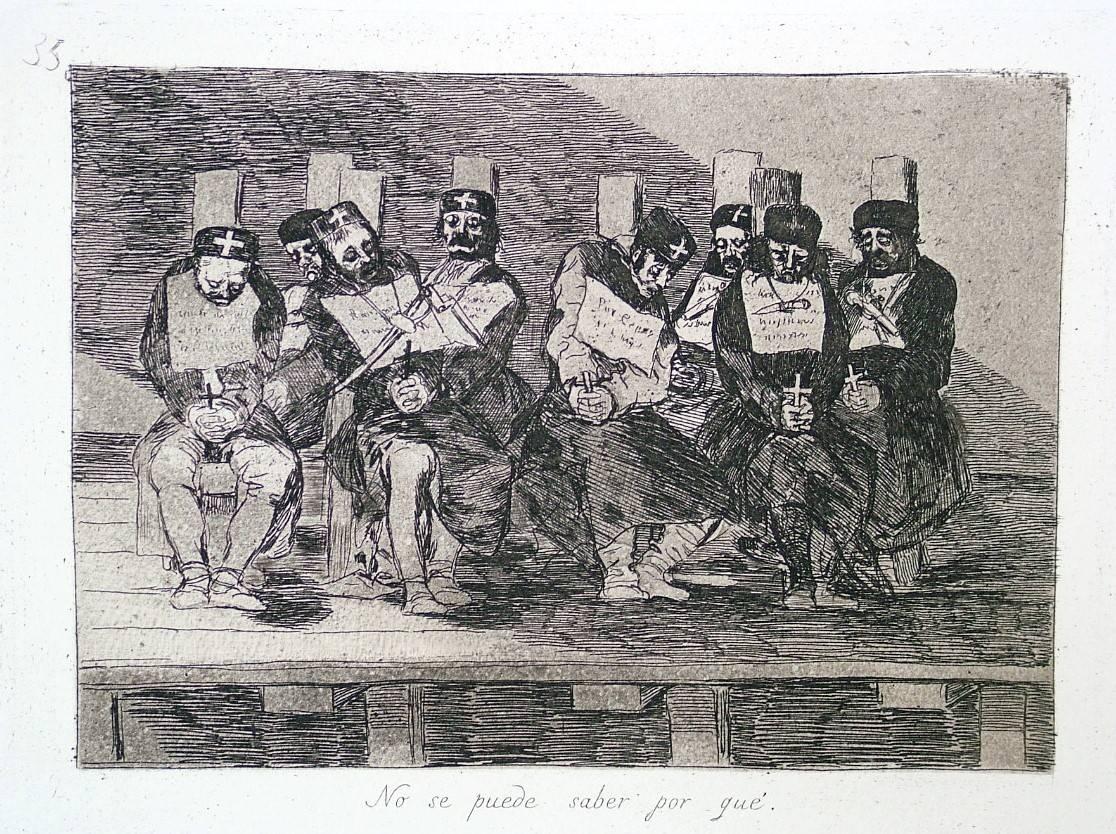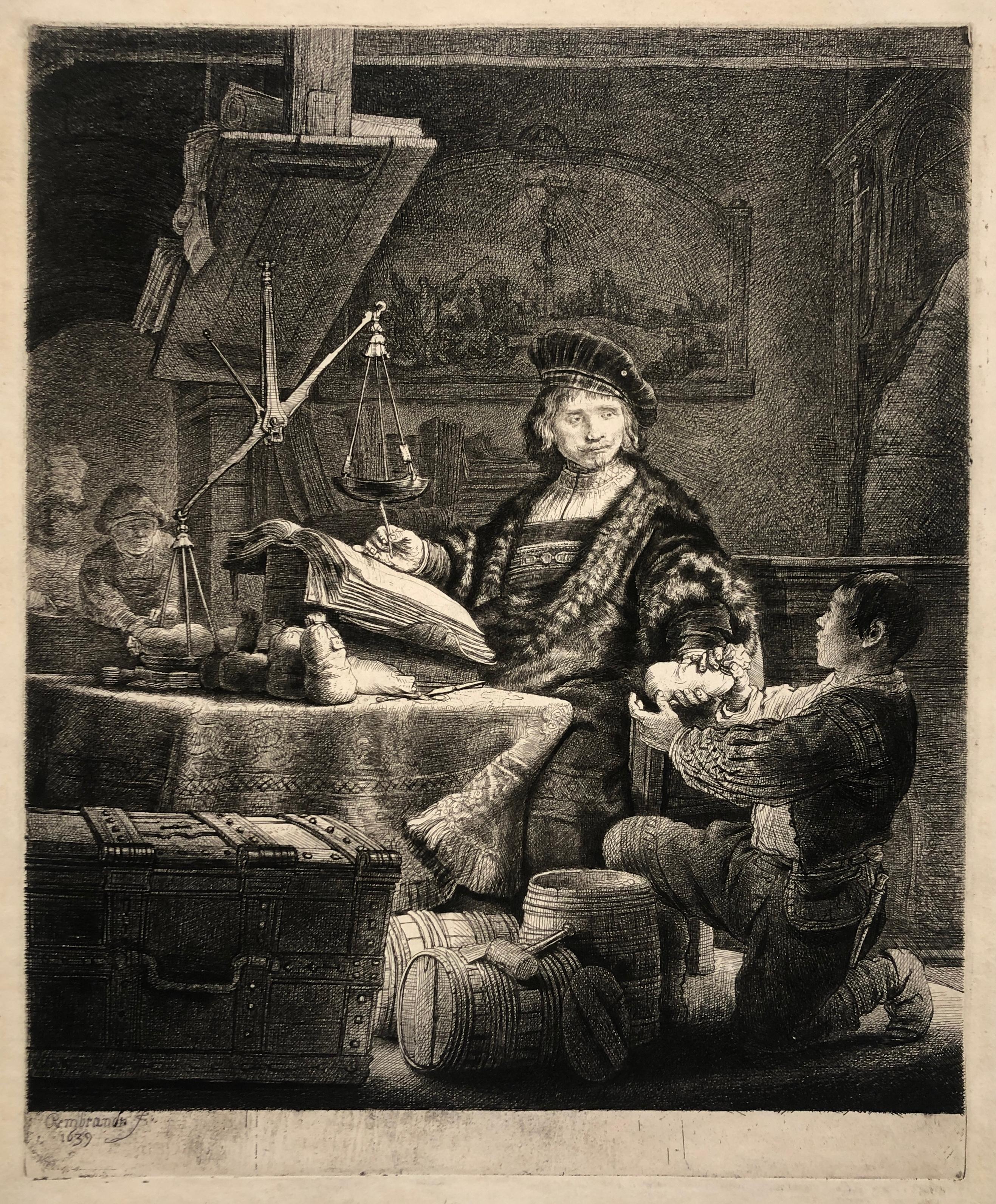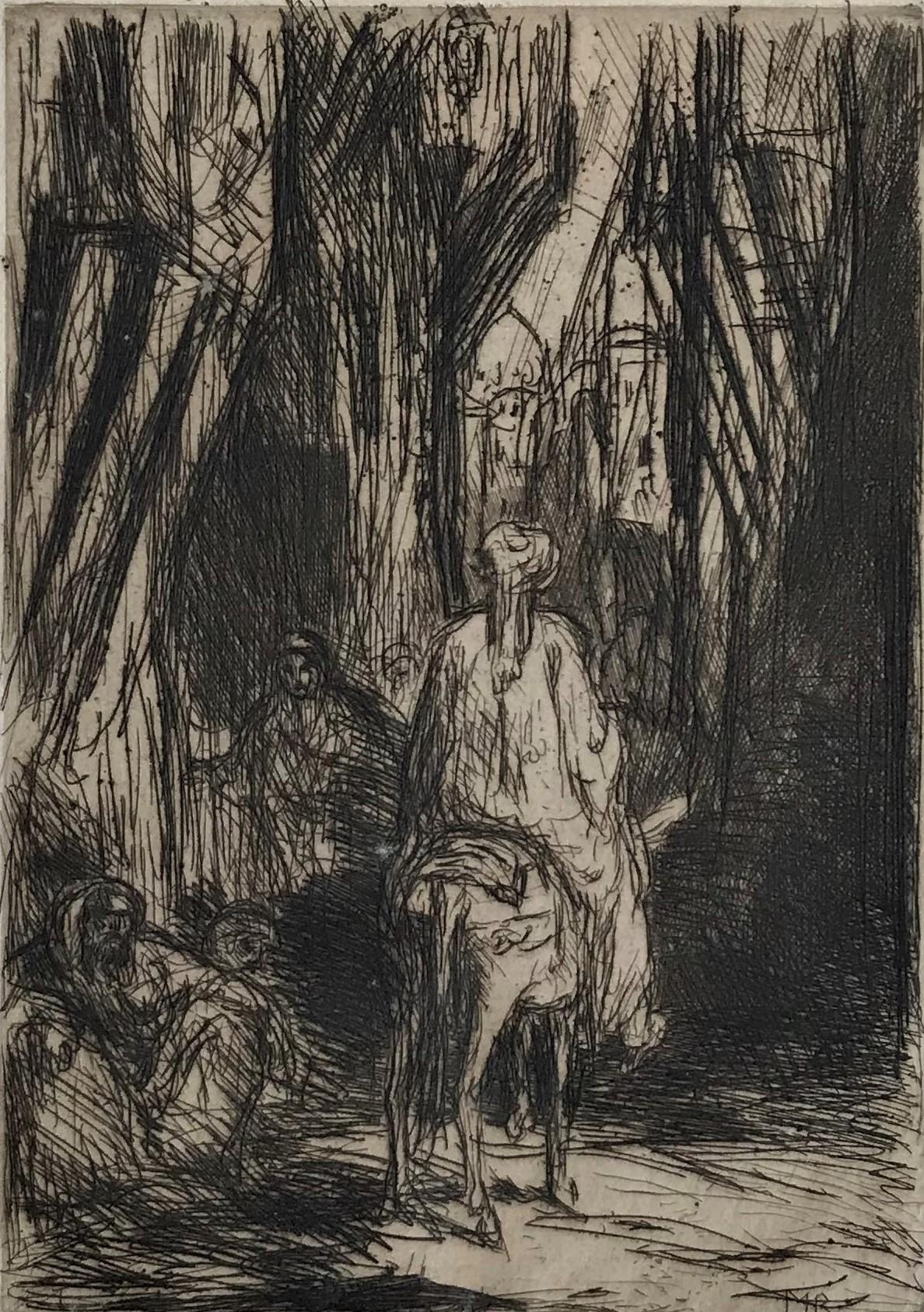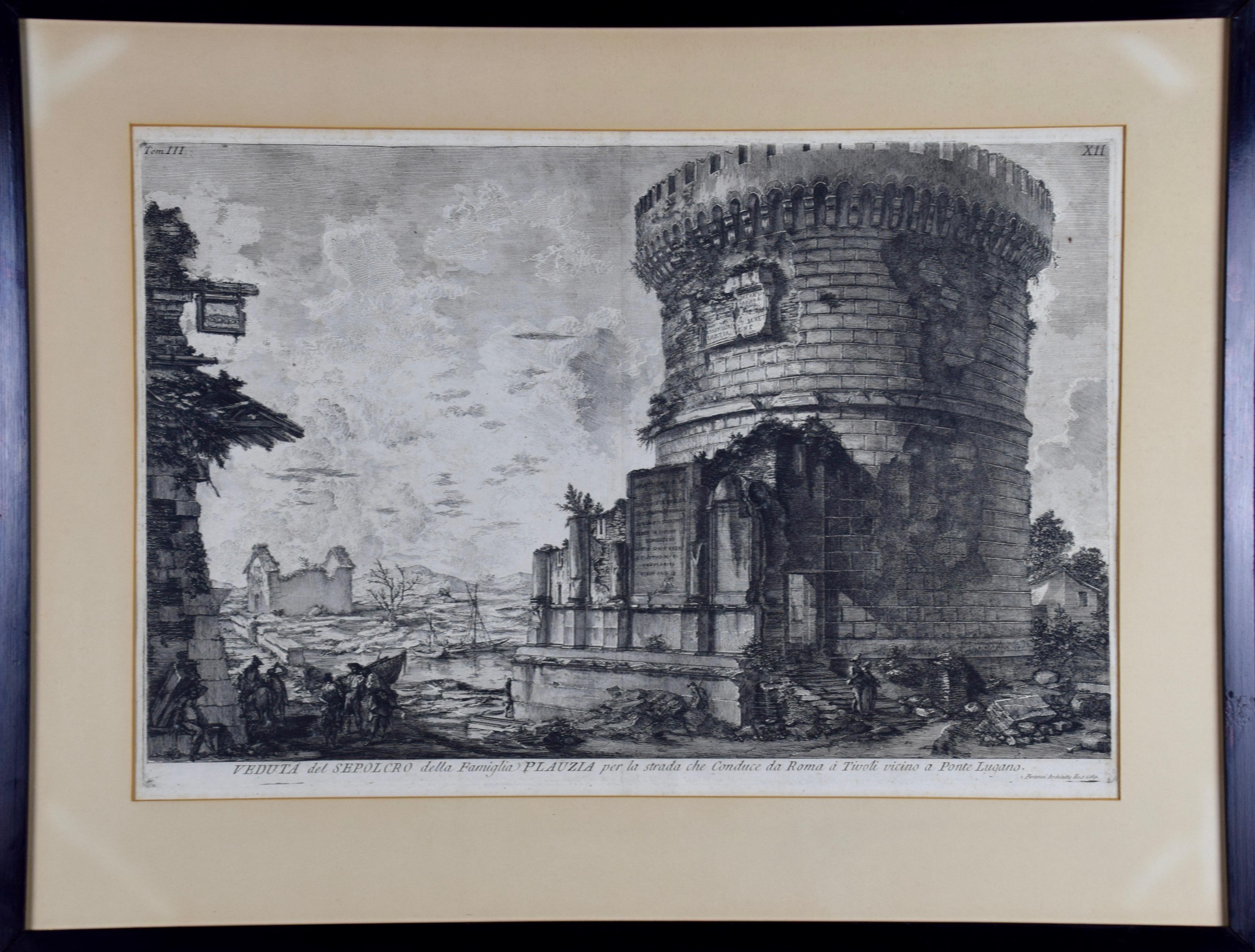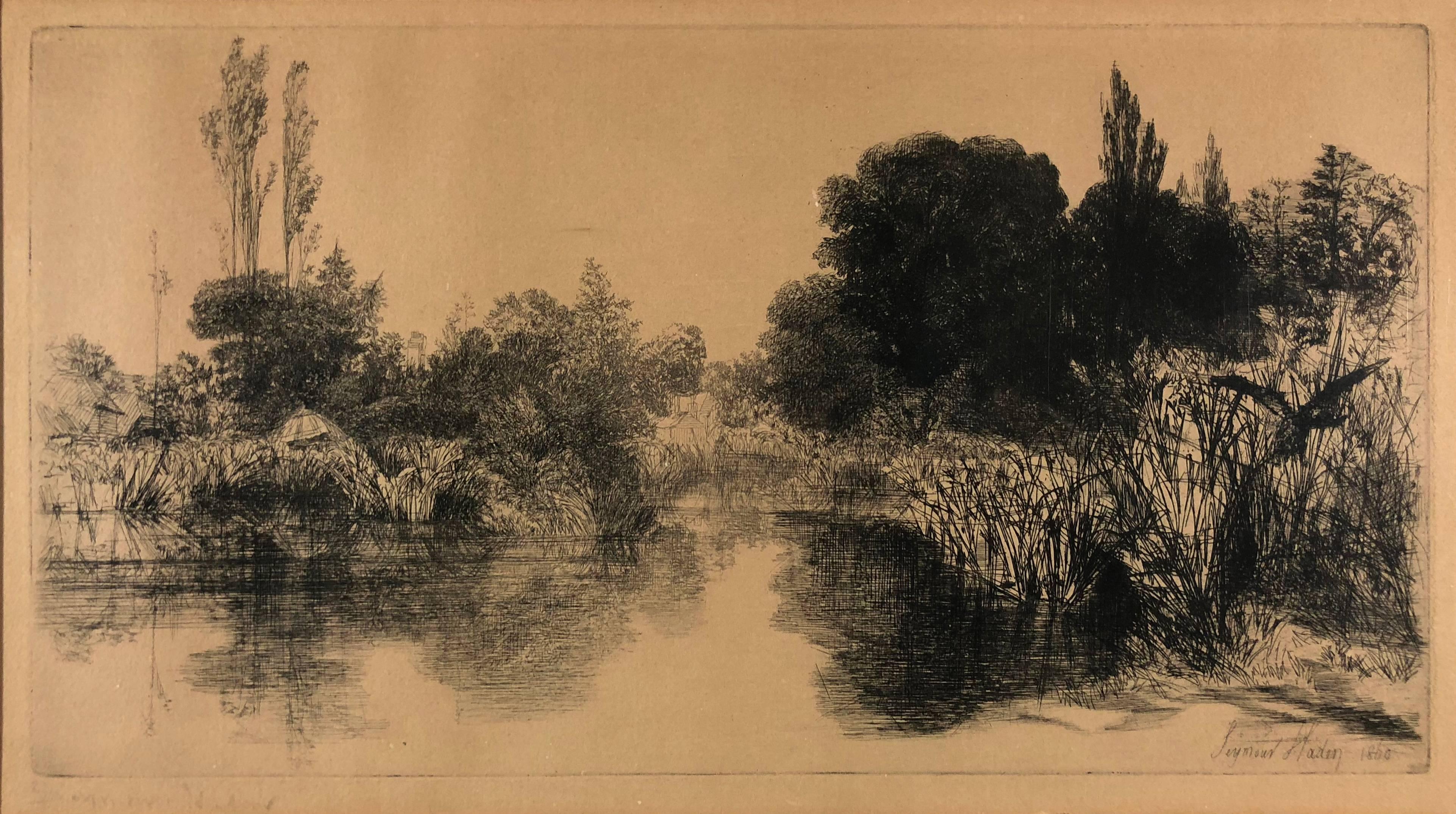Items Similar to Death Appearing to a Wedded Couple from an Open Grave
Want more images or videos?
Request additional images or videos from the seller
1 of 4
Rembrandt van RijnDeath Appearing to a Wedded Couple from an Open Grave1639
1639
About the Item
REMBRANDT HARMENSZ. VAN RIJN
1606 Leiden Amsterdam 1669
Death Appearing to a Wedded Couple from an Open Grave 1639
drypoint and etching; 109 x 78 mm
Bartsch 109, White/Boon only state; Hind 65; New Hollstein 174, only state
PROVENANCE: extensive provenance history available on request.
Although the themes of love and death were very popular in seventeenth-century Dutch art, the motifs were usually disguised. This very direct confrontation harks back to such earlier representations as Drers Promenade (Meder 83). Accordingly, the figures themselves are clothed in sixteenth-century costume and seem to be amused rather than frightened by the skeleton before them.
This is an extraordinarily good impression of a delicately wrought plate, with all the very finest lines intact (see, for instance, the lightest lines of her flowing hair, and the proving marks below the borderline), with touches of burr, especially towards the bottom. In later impressions, the sharpness of the lines diminishes, the finest lines break or even disappear. Esdailes impression, now at the Metropolitan, is better than the Morgans, but again there are no light scratches below the border, the hair is weak and there is no burr.
Such is the quality of line, in fact, that the characteristics of both this and the other impressions lead one to suspect that the print may be wholly executed in drypoint.
Even early commentators in the eighteenth century have described this print as rare.
[Note: I’m indebted to colleague Armin Kunz for these notes on this fine print]
- Creator:Rembrandt van Rijn (1606 - 1669, Dutch)
- Creation Year:1639
- Dimensions:Height: 42.92 in (109 cm)Width: 30.71 in (78 cm)Depth: 0.04 in (1 mm)
- Medium:
- Movement & Style:
- Period:1630-1639
- Condition:
- Gallery Location:New York, NY
- Reference Number:1stDibs: LU515313494972
Rembrandt van Rijn
Rembrandt was the most influential 17th Century Dutch painter. After years of early success as a portrait painter, his life was beset by financial hardship and personal tragedy. He continued to paint portraits and develop etchings. Rembrandt's portraits of his contemporaries, self-portraits and illustrations of scenes from the Bible are regarded as his greatest creative triumphs. His self-portraits form a unique and intimate autobiography, in which the artist surveyed himself without vanity and with the utmost sincerity. Like many artists of the Dutch Golden Age, such as Jan Vermeer of Delft, Rembrandt was also an avid art collector and dealer. Rembrandt never went abroad, but he was considerably influenced by the work of the Italian masters and Netherlandish artists who had studied in Italy, like Pieter Lastman, the Utrecht Caravaggists, Flemish Baroque, and Peter Paul Rubens. Rembrandt's foremost contribution in the history of printmaking was his transformation of the etching process from a relatively new reproductive technique into a true art form, along with Jacques Callot. His reputation as the greatest etcher in the history of the medium was established in his lifetime and never questioned since. Few of his paintings left the Dutch Republic while he lived, but his prints were circulated throughout Europe, and his wider reputation was initially based on them alone.
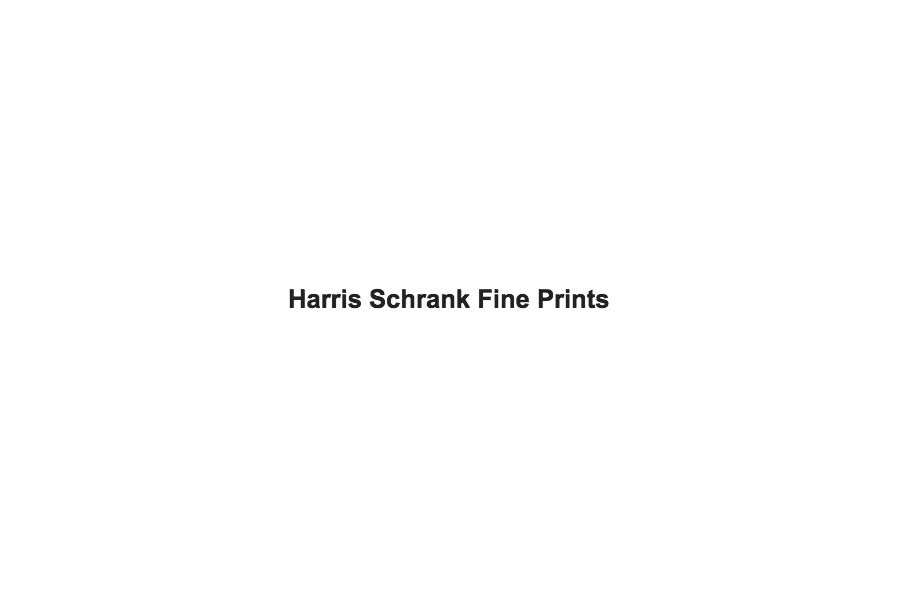
About the Seller
4.9
Recognized Seller
These prestigious sellers are industry leaders and represent the highest echelon for item quality and design.
Established in 2000
1stDibs seller since 2016
100 sales on 1stDibs
Typical response time: 3 hours
Associations
International Fine Print Dealers Association
- ShippingRetrieving quote...Ships From: New York, NY
- Return PolicyA return for this item may be initiated within 7 days of delivery.
More From This SellerView All
- One Can't Tell Why - Proof from the Disasters of WarBy Francisco GoyaLocated in New York, NYFrancisco José de Goya y Lucientes (1746 Fuendetodos – Bordeaux 1828), No se puede saber por qué – One can’t tell why ca. 1808–1814, etching, burnished aquatint, drypoint, an...Category
1810s Old Masters Figurative Prints
MaterialsDrypoint, Etching, Aquatint
- Descending from the Cross, by TorchlightBy Rembrandt van RijnLocated in New York, NYRembrandt Harmensz. van Rijn 1606 Leiden – Amsterdam 1669 The Descent from the Cross by Torchlight 1654 etching and drypoint; sheet 213 x 163 mm (8 3/8 x 6 7/16 inches) Bart...Category
17th Century Old Masters Figurative Prints
MaterialsDrypoint, Etching
- The Mill, Amsterdam, 1889By James Abbott McNeill WhistlerLocated in New York, NYJames Whistler (1834-1903), The Mill, 1889, etching and drypoint, signed in pencil with the butterfly on the tab and inscribed “imp”, and inscribed “first state” (twice) and annotated “Wunderlich” and signed again with the butterfly verso. Reference: Kennedy 413, first state (of 5). Glasgow 457, second state (of 6; see discussion below) (cf. Margaret F. MacDonald, Grischka Petri, Meg Hausberg, and Joanna Meacock, James McNeill Whistler: The Etchings, a catalogue raisonné, University of Glasgow, 2011) On laid paper, in very good condition, trimmed just outside of the platemark all around except for the tab by the artist, 6 1/4 x 9 3/8 inches. A very fine impression of this great rarity, printed in black/brown ink with a slight veil of plate tone. provenance: H. Wunderlich & Co., New York Louis B. Dailey, New York (Lugt 4500) sale, Sotheby’s, New York, October 31, 2003, lot 69 literature; Neue Lagerliste 122: James McNeill Whistler – Etchings...Category
1880s Impressionist Landscape Prints
MaterialsDrypoint, Etching
- VenusBy James Abbott McNeill WhistlerLocated in New York, NYJames Whistler (1834-1903), Venus, 1859. Etching and drypoint, printed in black ink on laid paper, an impression in the second (final) state: there was no published edition. 6 x 9 inches (15 x 22.6 cm) sheet 73/8 x 117/8 inches (18.8 x 30.3 cm) Reference: Kennedy 59; Glasgow 60 A very fine impression. A study of Héloïse, ‘Fumette’, asleep in bed, her head pressed into the pillow and the bedclothes covering her lower legs. This is one of three portraits Whistler made of Fumette in 1859: one of the others shows her standing and in the third only her head and shoulders are depicted. Venus is a work in the Realist tradition, and may be compared with Courbet’s nudes of the same period. The artist may also have had in mind Rembrandt’s study of Antiope in his etching Jupiter and Antiope. Venus was never published and there is no record of it being shown until 1898 when it was included in an Exhibition of Etchings, Drypoints and Lithographs by Whistler at H. Wunderlich & Co., New York. To have been overlooked for exhibition until so late in Whistler’s life might suggest that the subject was considered improper. Frederick Wedmore, whose catalogue of Whistler’s etchings...Category
1850s Impressionist Nude Prints
MaterialsDrypoint, Etching
- J.H. Woods’ Fruit Shop, ChelseaBy James Abbott McNeill WhistlerLocated in New York, NYJames Whistler (1834-1903), J.H. Woods’ Fruit Shop, Chelsea, etching and drypoint, 1887-88. Signed with the butterfly on the tab and annotated “imp,” also signed with the butterfly in pencil verso and numbered “1”. References: Kennedy 265 second state (of 2), Glasgow 327 second state (of 4). Trimmed by the artist around the plate mark except for the tab, in excellent condition. Printed in black ink on ivory laid paper, 3 3/4 x 5 1/8 inches. A fine impression of this great rarity; the print was never published. Glasgow accounts for four impressions. watermark: partial arms of Amsterdam(cf. Spink/Stratis/Tedeschi, watermark nos. 12ff.) This is before the third state in which heavy shading was added around the woman at the center, and the heads of figures at right and left of the figure are defined. In Glasgow’s fourth state the shading and the figure were removed; no impression is known of this state, but the state is inferred from the cancelled plate. According to Glasgow “Joseph Henry Wood had a greengrocer’s shop at 1 Park Walk...Category
1880s Impressionist Landscape Prints
MaterialsEtching, Drypoint
- Laburnums and BatterseaBy Theodore Casimir RousselLocated in New York, NYTheodore Roussel, Laburnums and Battersea, etching and drypoint, 1889/1890 and 1898; signed in the plate lower right, and signed in pencil on the tab, with the inscription IMP. Hausb...Category
Late 19th Century Realist Landscape Prints
MaterialsEtching, Drypoint
You May Also Like
- Jan Uytenbogaert, The GoldweigherBy Rembrandt van RijnLocated in Boston, MABartsch 281, Hind 167 iii/III, Nowell-Usticke 281, iii/III. A fine impression, with burr, as retouched by Baillie in 1792. With an unidentified collectors stamp, verso.Category
17th Century Old Masters Figurative Prints
MaterialsDrypoint, Etching
- Street in SmyrnaBy Marius BauerLocated in Storrs, CTStreet in Smyrna. 1889. Etching. Wisselingh 34. 7 x 5 1/4 (sheet 12 7/8 x 8 7/8).Edition 100, number 49. A rich, tonal impression printed on Strasbourg cream laid paper on the full s...Category
Late 19th Century Old Masters Figurative Prints
MaterialsDrypoint, Etching
- COTTAGE AND OBELISK ON THE SPAARNDAMMERDIJKBy Rembrandt van RijnLocated in San Francisco, CAOriginal etching and drypoint printed in black ink on laid paper. A strong and dark 17th century/lifetime impression of Bartsch, Usticke and New Hollstein’s second and final stat...Category
18th Century and Earlier Old Masters Landscape Prints
MaterialsDrypoint, Etching
- Giovanni Piranesi Etching of Ancient Roman Architecture, 18th CenturyBy Giovanni Battista PiranesiLocated in Alamo, CA"Veduta del Sepolcro della Famiglia Plauzia per la Strada Che Conduce da Roma a Tivoli vicino a Ponte Lugano" from "Le Antichità Romane" (Roman Antiquities), one of the most famous works by Piranesi. "Antichita" illustrates the tombs along the Appian Way...Category
Early 18th Century Old Masters Figurative Prints
MaterialsDrypoint, Engraving, Etching
- Shere Mill PondBy Sir Francis Seymour Haden, R.A.Located in Missouri, MOShere Mill Pond, No. II (large plate). 1860. Etching and drypoint. Schneiderman 37.v/ix. 7 x 13 1/8 (sheet 10 3/4 x 16 3/8). This state is prior to publication in Études à l'Eau-Forte. Illustrated: Keppel The Golden Age of Engraving; Print Collector's Quarterly 1 (1911): 18; : Guichard, British Etchers, 1850-1940. A rich, brilliant proof with drypoint burr printed on white laid paper. Signed in pencil. ------------------------------------------------------------------------------------------- Shere Mill Pond, No. II was one of the most highly praised landscape prints of the etching revival. An impression was exhibited at the Royal Academy in 1861 under Haden’s pseudonym, H. Dean. Francis Seymour Haden used this anagram of his own name early in his career as an artist, in order to retain his anonymity and preserve his professional reputation as a surgeon. Biography: Sir Francis Seymour Haden (16 September 1818 - 1 June 1910), was an English surgeon, best known as an etcher. He was born in London, his father, Charles Thomas Haden, being a well-known doctor and lover of music. He was educated at Derby School, Christ's Hospital, and University College, London, and also studied at the Sorbonne, Paris, where he took his degree in 1840. He was admitted as a member of the College of Surgeons in London in 1842. In 1843-1844, with his friends Duval, Le Cannes and Colonel Guibout, he travelled in Italy and made his first sketches from nature. Haden attended no art school and had no art teachers, but between 1845 and 1848 he studied portfolios of prints belonging to a second-hand dealer named Love, who had a shop in Bunhill Row, the old Quaker quarter of London. Arranging the prints in chronological order, he studied the works of the great original engravers, Albrecht Dürer, Lucas van Leyden and Rembrandt. These studies, besides influencing his original work, led to his important monograph on the etched work of Rembrandt. By lecture and book, and with the aid of the memorable exhibition at the Burlington Fine Arts Club in 1877, he tried to give a true reflection of Rembrandt's work, giving a nobler idea of the master's mind by taking away from the list of his works many dull and unseemly plates that had long been included in the lists. His reasons were founded upon the results of a study of the master's works in chronological order, and are clearly expressed in his monograph, The Etched Work of Rembrandt critically reconsidered, privately printed in 1877, and in The Etched Work of Rembrandt True and False (1895). Haden's printmaking was invigorated by his much younger brother-in-law, James Whistler, at the Haden home in Sloane Street in 1855. A press was installed there and for a while Haden and Whistler collaborated on a series of etchings of the Thames. The relationship and project did not last. Haden followed the art of original etching with such vigour that he became not only the foremost British exponent of that art but brought about its revival in England. His strenuous efforts and perseverance, aided by the secretarial ability of Sir WR Drake, resulted in the foundation of the Royal Society of Painter-Etchers and Engravers. As president he ruled the society with a strong hand from its first beginnings in 1880. Notwithstanding his study of the old masters of his art, Haden's own plates were very individual, and are particularly noticeable for a fine original treatment of landscape subjects, free and open in line, clear and well divided in mass, and full of a noble and dignified style of his own. Even when working from a picture his personality dominates the plate, as for example in the large plate he etched after J.M.W. Turner's "Calais Pier," which is a classical example of what interpretative work can do in black and white. Of his original plates, more than 250 in number, one of the most notable was the large "Breaking up of the Agamemnon." An early plate, rare and most beautiful, is "Thames Fisherman". "Mytton Hall" is broad in treatment, and a fine rendering of a shady avenue of yew trees leading to an old manor-house in sunlight. "Sub Tegmine" was etched in Greenwich Park in 1859; and "Early Morning--Richmond", full of the poetry and freshness of the hour, was done, according to Haden, actually at sunrise. One of the rarest and most beautiful of his plates is "A By-Road in Tipperary"; "Combe Bottom" is another; and "Shere Mill Pond" (both the small study and the larger plate), "Sunset in Ireland," "Penton Hook," "Grim Spain" and "Evening Fishing, Longparish," are also notable examples of his genius. A catalogue of his works was begun by Sir William Drake and completed by Harrington in 1880. During later years Haden began to practise the sister art...Category
Late 19th Century Old Masters Landscape Prints
MaterialsEtching, Drypoint
- Study of Six Heads - Etching by J.-J. BoissieuBy Jean-Jacques de BoissieuLocated in Roma, ITStudy of Six Heads is a beautiful black and white etching with drypoint interventions on paper, realized at the end of XVIII century by the French artist Jean-Jacques de Boissieu (Lyon, 1736- 1810). Six study od heads ( four elder men, a middle-aged man at the center, and a woman with turbant) etched with a superb technique and an incredible draftsmanship are drawn to different scales and with different degrees of finish, have the dignity of six different portraits with the same passion and effort. Signed on plate on lower right margin “De Boissieu”. Inscription ( number plate) on higher-right corner "10". This old master’s original print with lifetime impressions, is in very good conditions, except for a usual yellowing of the paper above all on the edges and some signs of the time,do not affect the image. Jean-Jacques de Boissieu (Lyon,1736 –1810) Jean-Jacques de Boissieu was a French artist studied at the École de Dessin in Lyon, but he was mostly self-taught. His first prints were realized between 1758–64. When he went to Italy in the retinue of the ambassador and Duc de la Rochefoucauld d’Enville, he had the lifechanging encounter: he met Voltaire and he entered in the world of luminaries, he had the opportunity of realizing some plates for the Diderot-d’Alembert’s Encyclopèdie. Then he continued to produce prints in Lyon, Boissieu made many etchings of the Roman and Dutch countryside, as well as the French countryside around Lyon, which earned him a reputation as the last representative of the older etching...Category
Late 18th Century Old Masters Animal Prints
MaterialsEtching, Drypoint
Recently Viewed
View AllMore Ways To Browse
Botanical Engraving
20th Dutch Prints
Blue Vintage Books
Painting On Silk Vintage
Vintage Posters Orange
Friendship Sculpture
Tokyo Pop
20th Century Etching Lithograph
Amsterdam Etching
Travel Prints 1960s
Vintage Play Posters
1975 Posters
Church Window
Signed Japanese Plate
Signed Picasso Etching
Framed Engravings London
German Surrealism
Hand Signed Dali
